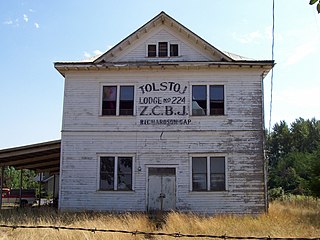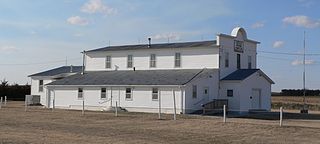Czechs in Omaha, Nebraska have made significant contributions to the political, social and cultural development of the city since the first immigrants arrived in 1868.
The Czech-Slovak Protective Society (CSPS), which became the Czecho Slovakian Association, was an organization supporting the welfare of Czech and Slovak immigrants to the United States. The Czech-Slovak Protective Society started as an insurance services organization. It was once the largest Czech-American freethought fraternity in the United States.
Bohemian Hall may refer to:

The Z.C.B.J. Opera House is a building in Verdigre, Nebraska, United States, that was built in 1903. It was listed on the National Register of Historic Places in 1988. It serves as a meeting hall for the Czech community.

The ZCBJ Hall, also known as Community Hall, is a building in Haugen, Wisconsin, United States, that was built in 1910. It was listed on the National Register of Historic Places in 1985. It historically served as a meeting hall for the Czech community.

The Z.C.B.J. Tolstoj Lodge No. 224, also known as Bohemian Hall or Tolstoj Sokol Lodge, is a historic building in rural Linn County southeast of Scio, Oregon, United States, that was built in 1911. It was listed on the National Register of Historic Places on September 14, 1995. It historically served as a meeting hall for the Czech community. The lodge organized a Czech school, in addition to hosting concerts, dances, Sokol events and Fourth of July celebrations.

The ZCBJ Hall is a building in Tyndall, South Dakota, United States that historically served as a meeting hall for the Czech community. The building, formerly a high school, was purchased by Zapadni Ceska Bratrska Jednota from the Tyndall Independent School Dist. No.3 in 1908. It was listed on the National Register of Historic Places on January 31, 1985.

The Rad Slavin cis. 112 Z.C.B.J. Hall, also known as National Hall, is a building in Comstock, Nebraska, United States, that was built in 1909. It was listed on the National Register of Historic Places on November 12, 1992. It historically served as a meeting hall for the Czech community.

The Rad Jan Kollar cis 101 Z.C.B.J., also known as Z.C.B.J. Hall, is a historic building near Du Bois, Nebraska, United States, that was built in 1920-21. It was listed on the National Register of Historic Places in 1990. It historically served as a meeting hall for the Czech community.

The Rad Saline Center cis. 389 Z.C.B.J., also known as Saline Center Lodge Hall, is an historic building in rural Nebraska located about 9 miles north of Western, Nebraska that was built in 1939. It was listed on the National Register of Historic Places on January 4, 1996. It historically served as a meeting hall for the Czech community.

The Z.C.B.J. Rad Tabor No. 74, also known as Tabor Hall, is an historic building located south of Dorchester in rural Saline County, Nebraska. It was built in 1914; a large dance pavilion was added in 1934. It was listed on the National Register of Historic Places on August 23, 1985. It historically served as a meeting hall for the Czech community, hosting Czech language classes and Sokol events.

The Rad Plzen cis. 9 ZCBJ (SD10-6) is a building located in Morse Bluff, Nebraska that was built in 1911. It was listed on the National Register of Historic Places on March 20, 1986. The building historically served as a meeting hall for the Czech community. It was the meeting hall for the ZCBJ Lodge Plzen, a branch of the Zapadni Ceska Bratrska Jednota. The ZCBJ Lodge Plzen was originally organized on June 6, 1880 as a branch of the Czech-Slovak Protective Society, but was incorporated into ZCBJ in 1897.

The ZCBJ Lodge No. 46, also known as Bohemian Hall, is an historic building located in Prague, Oklahoma that was built in 1917. It was listed on the National Register of Historic Places on March 8, 1984. The building historically served as a meeting hall for the Czech community, hosting a Zapadni Ceska Bratrska Jednota lodge that was the oldest Czech fraternal order in Oklahoma. The lodge was originally organized in 1891 as a branch of the Czech-Slovak Protective Society, but was incorporated into Zapadni Ceska Bratrska Jednota in 1897.

Z.C.B.J. Opera House is an historic building located in Clarkson, Nebraska, United States, that was built in 1913 by the Zapadni Ceska Bratrska Jednota, or Western Bohemian Fraternal Association. It was listed on the National Register of Historic Places on September 28, 1988. The building serves as a meeting hall for the Czech community. It has hosted operas, dances, lectures, films and Czech heritage events.

The Rad Sladkovsky lodge, also known as Pishelville Hall, is a building located near Verdigre, Nebraska that was built in 1884. It was listed on the National Register of Historic Places on June 29, 1982. The building historically served as a meeting hall for the Czech community, hosting a Zapadni Ceska Bratrska Jednota (ZCBJ) lodge that was the oldest Czech fraternal order in Nebraska. The lodge was originally organized as a branch of the Czech-Slovak Protective Society, but was incorporated into the ZCBJ in 1897.

The Western Fraternal Life Association, previously known as Zapadni Ceska Bratrska Jednota is a fraternal benefit society and financial services organization in the United States. The association has its roots in the Czechoslovak immigrant community of the 19th century. It was once the second largest Czech-American freethought fraternity in the United States.

The Western Bohemian Fraternal Union Hall is a historic clubhouse in Meadowlands Township, Minnesota, United States. It was built in 1925 as a meeting hall for a lodge of the Western Bohemian Fraternal Union, a society of Czech Americans. The hall also served as a host for Sokol gymnastics events. The hall was listed on the National Register of Historic Places in 1986 for its local significance in the themes of European ethnic heritage and social history. It was nominated for being a long-serving rural venue for the preservation of Czech American culture and heritage.

Lodge Zare Zapadu#44, known locally as Yellow Brick Hall and also known as Bohemian Brick Hall and Z.G.B.J. Council Hall #44, is a historic clubhouse of the Zapadni Ceska Bratrska Jednota serving the Czech-American community in rural Freeborn County, Minnesota, United States.
Lodge Boleslav Jablonsky No. 219 is the meeting hall of a Czech American fraternal society in Poplar Grove Township, Minnesota, United States. The hall was built in 1916 and remains in use as of 2016. It was listed on the National Register of Historic Places in 2002 for having local significance in the themes of European ethnic heritage and social history. It was nominated for being a representative of ethnic history in the last part of Minnesota to be settled by Euro-Americans.

















